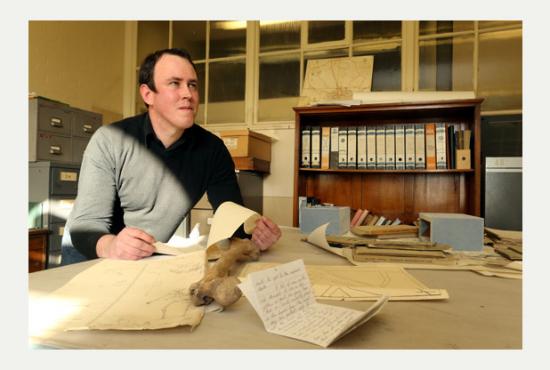One man's mission to unearth Nottingham's ancient skeleton mystery
Source -http://www.nottinghampost.com/man-s-mission-unearth-ancient-skeleton-mystery/story-20609697-detail/story.html#ixzz2t7xtWmDU

Scott Lomax is carrying out research on bones discovered in central Nottingham
Back in 1962, Nottingham was not quite so curious about its past. When labourer James Beeson unearthed human bones, there was flurry of interest – and more bones were discovered during an archaeological dig in 1963 and by builders preparing the ground for a new office block.
But then most of the bones were boxed, under the supervision of a priest, and taken to Wilford Cemetery.
The theory at the time was that the skeletons and partial skeletons of some 70 bodies dated from the 19th Century.
Happily for pursuers of truth, one skeleton was kept – stored in a cardboard box at Wollaton Hall – and it has allowed archaeologist Scott Lomax to revise the story of the Cranbook Street bones.
"The original theory was that they had died in the 1831 cholera outbreak," says Mr Lomax. "But we now know that there had been buildings on the site since 1820 – so the remains had to be pre-1820.
"I obtained funding from the Council for British Archaeology to have the bones carbon-dated and they went last year to Oxford University Radiocarbon Acceleration Unit."
The results of those tests make the Cranbrook Street bones Nottingham's most important archaeological discovery since the 1980 Halifax Place excavations, which found evidence of Saxon buildings.
The bones, it transpired, date not from the 19th Century, but the first half of the 15th.
"The dates are between 1415 and 1450, within a 95.4 per cent probability," says Mr Lomax, who is pursuing the bones story in the evenings and at weekends – his day job is working with archaeology contractors Trent and Peak on an English Heritage-funded project called the Origins of Nottingham.
That puts the deaths in the later years of the medieval era, between King Henry V's triumph at Agincourt and the period of dynastic feuding that led to the Wars of the Roses.
So what do we know of the Nottingham in which these people came to grief?
Built on the north bank of the River Leen, the town comprised the western "Norman" borough, centred on Nottingham Castle, and the older Saxon borough to the east, occupying the district we now call the Lace Market.
Cranbrook Street is at the eastern edge of the latter area – and the low-lying, possibly boggy neighbourhood had become derelict following the Black Death of 1349.
Also in that area is Lennox Street, where the discovery of human remains was the subject of a photographic exhibition in 1935. Those remains, and the photographs, have disappeared – but Mr Lomax believes they are likely to be associated with the Cranbrook Street discovery.
So what is the story of those men and women? Were they given a formal Christian burial?
Probably not. In his book Nottingham: The Buried Past of a Historic City Revealed, Mr Lomax tells the story of the 1963 Cranbrook Street dig by archaeologist Tony Wass.
"None of the skeletons and partial skeletons was orientated," Mr Lomax writes. "Some were lying on top of one another at different angles, as if they had been hurriedly buried."
Violent deaths? Again, probably not. There is a hole in the side of the surviving skeleton's skull, but nothing to prove what caused it.
Says Mr Lomax: "My working hypothesis is that it was an epidemic of some sort, possibly a plague."
There is no record of a plague in Nottingham in the first half of the 15th Century – but then there is no local record of the earlier Black Death, which killed one third of the population. In spite of the lack of clues – the only object found with the bones was a horseshoe – the investigation continues.
Mr Lomax, from Chesterfield, had his heart set on archaeology from the age of eight, when a teacher showed him a film featuring the discovery of a Roman shoe near Hadrian's Wall.
He studied archaeology and prehistory at the University of Sheffield and has been closely involved in Nottingham's archaeology, in various capacities, since 2008, and much of his learning is contained in his book called Buried Past.
The next step in the mystery is to obtain funding for further analysis. We know about the bones, but what about the people? Isotopic analysis could tell us whether they were of local stock, or outsiders; it could yield clues about disease, diet and social status.
And a geophysical survey of the area could reveal the alignment of the Town Ditch – the boundary of medieval Nottingham. "It would make sense in a plague," says Mr Lomax, "if you disposed of the dead outside the town."
Far from being brought to a conclusion, the story of the Cranbrook Street bones has only just begun.